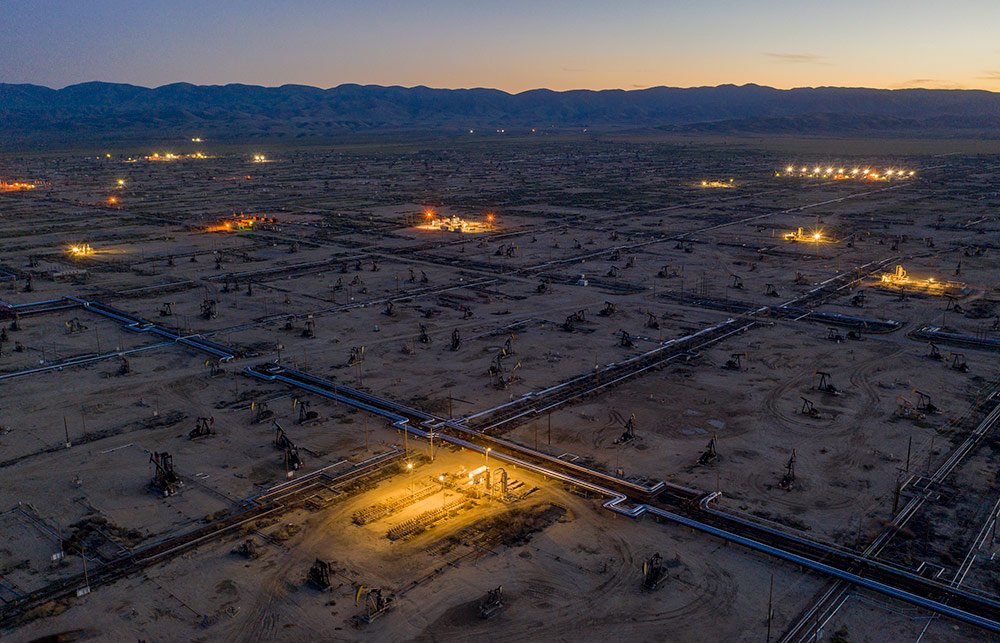本周二,荷兰皇家壳牌发布预警称,今年第二季度该公司资产最多将减值220亿美元。随着新冠疫情重塑全球需求,越来越多的公司开始估算石油和天然气悲惨的经济性,壳牌则是其中最大的一家。
这笔创纪录的资产减值也初步预示出该行业今后的状况。作为全球最大的非国有油气生产商,壳牌还面临着一个更艰巨的挑战,那就是摆脱化石燃料并转型,从而大幅降低自身的碳排放。
今年4月,壳牌曾经表示其目标是到2050年实现零排放,从而达到《巴黎协定》的要求。壳牌于本周一发布了资产减值公告,而就在两周前,英国大型能源公司英国石油,同时也是世界第二大非国有能源企业预测自身资产将减值175亿美元左右。今年2月,英国石油做出了和壳牌一样的减排承诺,是全球范围内率先迈出这一步的大型石油企业。
能源数据公司Wood Mackenzie负责企业分析的副总裁卢克•帕克在周二发表报告称:“壳牌披露的减值不光是会计处理方法,或者对短期价格预测的调整。它代表着席卷整个石油和天然气行业的根本性变化。”
“通过本次减值,壳牌向我们透露了有关其搁浅资产的信息,就像英国石油在几周前所做的那样。”
本次大幅减值背后有两大因素——短期价格评估和长期气候策略。很难将二者分离开来。

短期而言,世界各国的封城措施和经济危机造成全球能源需求下降,这让石油和天然气价格受到冲击,进而迫使企业重新评估它们的价格预期。但同时,这些公司预测的油气价格仍然处于盈利水平。
重估预期加快了众多公司的资产减值步伐,出现这种局面的时间实际上比疫情还早几个月。美国页岩油气行业的危机尤其严重,因为这些公司债台高筑,而天然气供给过剩又让全球油价持续下滑。
位于奥斯陆的咨询公司Rystad Energy发布的数据显示,今年第一季度危机刚刚出现时,页岩油气公司的资产就已经减值380亿美元。分析师们认为它们的资产减值只会越来越多。德勤就在本月初的报告中称,从第二季度开始,上述资产减值数字有可能达到至少3000亿美元。
这样的形势还让一些公司直接破产。本周初,又一家公司因为需求不断滑坡而倒下——页岩油行业先锋切萨皮克能源宣布破产。国际能源署则预测,今年油气需求将出现前所未有的下降。
不过,壳牌和英国石油的高额资产减值不光意味着经济上的困难。到目前为止,对于如何在今后20年里快速转型为低排放企业,两家公司几乎均未给出具体细节。但这样的转型显然要依靠一项简单的措施,那就是将油气行业未开采的诸多化石燃料资源留在地下,并将其价值归零。
因此,这些所谓的搁浅资产必须清除,而盘踞在《财富》世界500强榜单前列的石油和天然气公司以及能源依赖型经济的整体价值也将随之转变。对于这些公司的资产减值规模,外界预测不一,但往往都达到数十亿美元,甚至上万亿美元。
《金融时报》的一篇分析文章估算,要实现本世纪全球气温升幅不超过1.5摄氏度的目标,主要油气公司的总价值有可能蒸发9000亿美元,约占今年2月其总价值的三分之一。去年9月,独立金融研究机构Carbon Tracker Initiative预测,按照《巴黎协定》的目标,到2030年,整个油气行业有可能得放弃价值2.2万亿美元的资产。
帕克指出,上述资产减值释放的另一个信号可能关乎整个行业的根本性变化。
他说:“以后需求也许会上升,而且许多公司仍然想从这样的增长中分一杯羹。但毫无疑问,企业所处的格局正在发生变化,那些大型公司也将随之做出改变。”(财富中文网)
译者:Charlie
本周二,荷兰皇家壳牌发布预警称,今年第二季度该公司资产最多将减值220亿美元。随着新冠疫情重塑全球需求,越来越多的公司开始估算石油和天然气悲惨的经济性,壳牌则是其中最大的一家。
这笔创纪录的资产减值也初步预示出该行业今后的状况。作为全球最大的非国有油气生产商,壳牌还面临着一个更艰巨的挑战,那就是摆脱化石燃料并转型,从而大幅降低自身的碳排放。
今年4月,壳牌曾经表示其目标是到2050年实现零排放,从而达到《巴黎协定》的要求。壳牌于本周一发布了资产减值公告,而就在两周前,英国大型能源公司英国石油,同时也是世界第二大非国有能源企业预测自身资产将减值175亿美元左右。今年2月,英国石油做出了和壳牌一样的减排承诺,是全球范围内率先迈出这一步的大型石油企业。
能源数据公司Wood Mackenzie负责企业分析的副总裁卢克•帕克在周二发表报告称:“壳牌披露的减值不光是会计处理方法,或者对短期价格预测的调整。它代表着席卷整个石油和天然气行业的根本性变化。”
“通过本次减值,壳牌向我们透露了有关其搁浅资产的信息,就像英国石油在几周前所做的那样。”
本次大幅减值背后有两大因素——短期价格评估和长期气候策略。很难将二者分离开来。
短期而言,世界各国的封城措施和经济危机造成全球能源需求下降,这让石油和天然气价格受到冲击,进而迫使企业重新评估它们的价格预期。但同时,这些公司预测的油气价格仍然处于盈利水平。
重估预期加快了众多公司的资产减值步伐,出现这种局面的时间实际上比疫情还早几个月。美国页岩油气行业的危机尤其严重,因为这些公司债台高筑,而天然气供给过剩又让全球油价持续下滑。
位于奥斯陆的咨询公司Rystad Energy发布的数据显示,今年第一季度危机刚刚出现时,页岩油气公司的资产就已经减值380亿美元。分析师们认为它们的资产减值只会越来越多。德勤就在本月初的报告中称,从第二季度开始,上述资产减值数字有可能达到至少3000亿美元。
这样的形势还让一些公司直接破产。本周初,又一家公司因为需求不断滑坡而倒下——页岩油行业先锋切萨皮克能源宣布破产。国际能源署则预测,今年油气需求将出现前所未有的下降。
不过,壳牌和英国石油的高额资产减值不光意味着经济上的困难。到目前为止,对于如何在今后20年里快速转型为低排放企业,两家公司几乎均未给出具体细节。但这样的转型显然要依靠一项简单的措施,那就是将油气行业未开采的诸多化石燃料资源留在地下,并将其价值归零。
因此,这些所谓的搁浅资产必须清除,而盘踞在《财富》世界500强榜单前列的石油和天然气公司以及能源依赖型经济的整体价值也将随之转变。对于这些公司的资产减值规模,外界预测不一,但往往都达到数十亿美元,甚至上万亿美元。
《金融时报》的一篇分析文章估算,要实现本世纪全球气温升幅不超过1.5摄氏度的目标,主要油气公司的总价值有可能蒸发9000亿美元,约占今年2月其总价值的三分之一。去年9月,独立金融研究机构Carbon Tracker Initiative预测,按照《巴黎协定》的目标,到2030年,整个油气行业有可能得放弃价值2.2万亿美元的资产。
帕克指出,上述资产减值释放的另一个信号可能关乎整个行业的根本性变化。
他说:“以后需求也许会上升,而且许多公司仍然想从这样的增长中分一杯羹。但毫无疑问,企业所处的格局正在发生变化,那些大型公司也将随之做出改变。”(财富中文网)
译者:Charlie
When Royal Dutch Shell warned it will write down up to $22 billion in assets in the second quarter on Tuesday, it became the largest of an expanding group of companies to face a reckoning over the brutal economics of oil and gas as the coronavirus pandemic has warped global demand.
The record write-down for the company also provided an initial signal of what’s to come, as the world’s largest non–state-owned oil and gas company faces an even larger challenge: its own transition away from fossil fuels, in a bid to dramatically reduce its emissions.
In April, the Anglo-Dutch giant announced it would target net zero emissions by 2050, in order to align with the Paris Agreement. Its write-down announcement on Monday comes just two weeks after British energy giant BP, the world’s second largest non–state-owned energy company, said it expected to write down roughly $17.5 billion worth of assets. BP made the same commitment to cut emissions in February, then the first major oil company in the world to do so.
“The impairment Shell has announced is about more than an accounting technicality, or an adjustment to near-term price assumptions. It’s about fundamental change hitting the entire oil and gas sector,” said Luke Parker, vice president of corporate analysis at consultancy Wood Mackenzie, in a note on Tuesday.
“Within this write-down, Shell is giving us a message about stranded assets, just like BP did a few weeks ago.”
The two threads behind the massive write-downs—shorter-term price assessments and longer-term climate strategy—are difficult to separate.
In the nearer term, the decline in global energy demand owing to worldwide lockdowns and economic crises has rocked oil and gas prices, and forced companies to reassess their price forecasts—and therefore, which of their projects will still be profitable.
That reassessment has accelerated a spate of write-downs that had in fact begun months before the pandemic arrived. The U.S. shale sector in particular went into the crises struggling under the weight of sky-high debt levels and a glut of gas that had sent global prices spiraling downward.
In the first quarter, as the crisis was only beginning to take hold, shale companies alone wrote off $38 billion in assets, according to Rystad Energy, an Oslo-based consultancy. Analysts estimate those write-downs have only picked up steam, with Deloitte predicting in a report earlier this month that write-downs could hit at least $300 billion beginning in the second quarter.
Those same dynamics have also spurred outright bankruptcies. Earlier this week, the declining demand—which the International Energy Agency estimates will be the largest drop on record this year—claimed another victim, as shale pioneer Chesapeake Energy declared bankruptcy.
But Shell’s and BP’s hefty write-downs have more significance than economic hardship. Both companies have so far given little concrete detail about how they will transition rapidly to becoming low-emission companies within the next two decades. But such transitions are clearly dependent on a simple fact: Many of the industry’s unexploited fossil fuel resources will have to be left in the ground, eliminating their value.
Those so-called stranded assets will, as a result, have to be written off, transforming the value of oil and gas companies—a sector that dominates the top of the Fortune Global 500—and energy-dependent economies as a whole. Estimates of the scale of those write-downs vary, but they tend to be in the billions or trillions.
An analysis by the Financial Times estimated that enforcing a temperature rise below 1.5 degrees Celsius this century would wipe $900 billion in collective value off the largest oil and gas companies, or about one-third of their value as of February. Last September, the Carbon Tracker Initiative estimated oil and gas companies risked wasting a collective $2.2 trillion by 2030 on assets that would have to be abandoned under Paris Agreement–level targets.
The write-downs may also send a signal about a fundamental shift across the wider sector, notes Parker.
“Demand might still grow from here, and many companies are still chasing a share of that growth,” he said. “But make no mistake, the corporate landscape is changing, and the majors are changing with it.”






